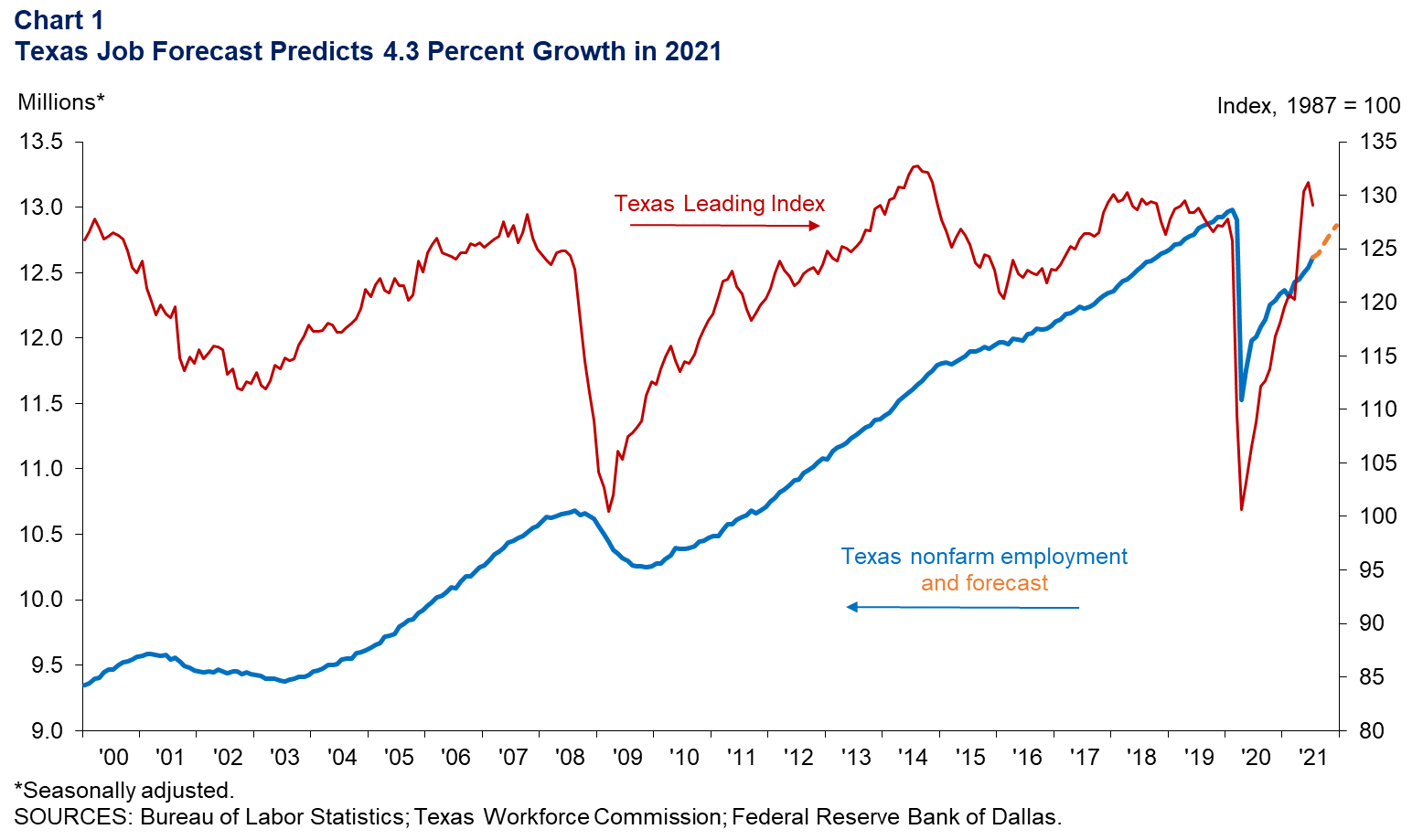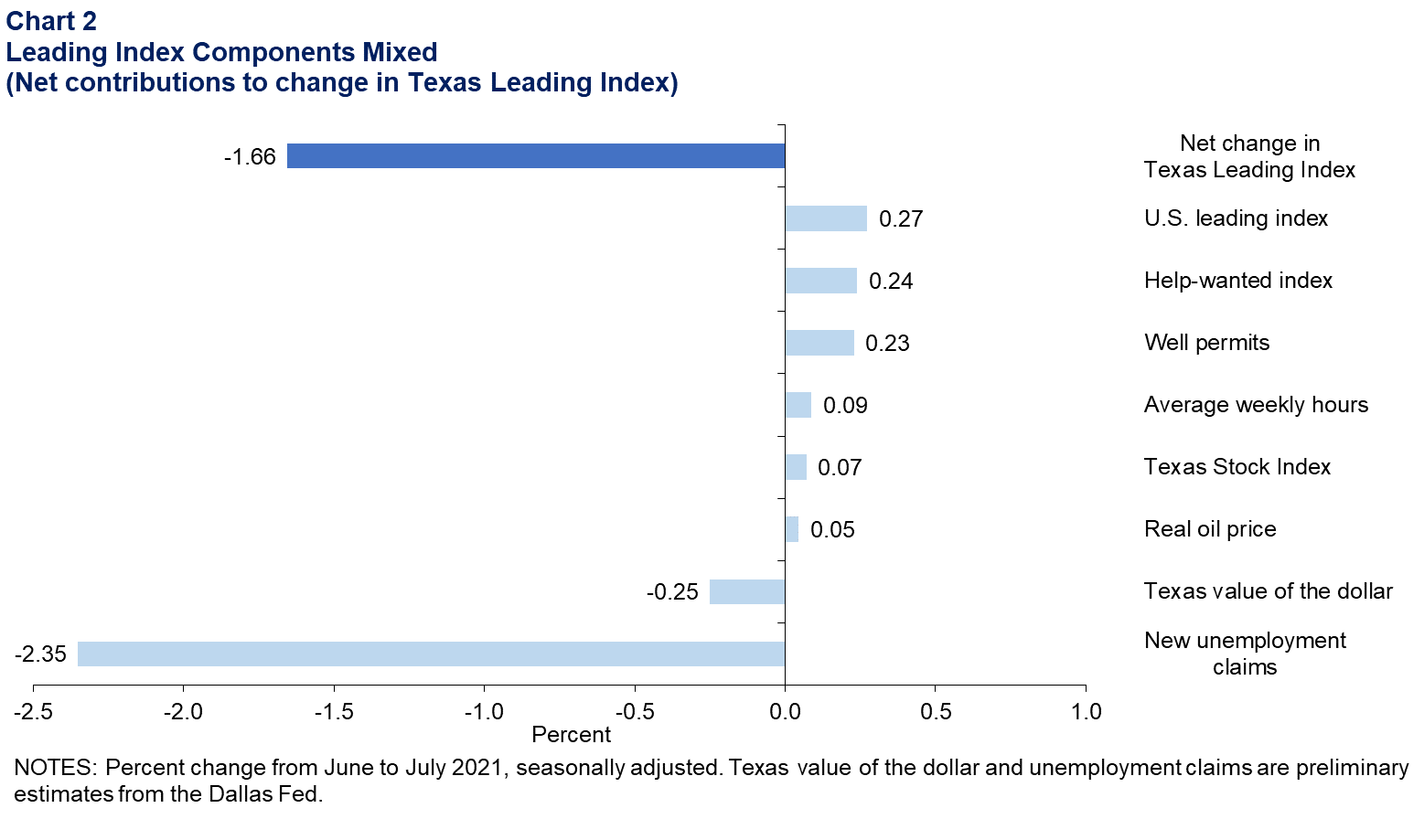Texas Employment Forecast

August 20, 2021
Texas employment grew at a 7.1 percent annualized rate in July after increasing by 4.3 percent in June. The Texas Leading Index decreased for the first time since March, primarily due to a rise in initial claims for unemployment insurance. The overall movement of the index over the past three months is still positive, however, suggesting positive growth over the next three to six months.
Using a top-down model based on national forecasts, Texas COVID-19 hospitalizations and oil futures prices, we estimate that jobs will increase by 4.3 percent in 2021—down from last month’s estimate of 5.6 percent—with an 80 percent confidence band of 3.6 percent to 5.0 percent. Based on the forecast, 527,700 jobs will be added in the state this year, and employment in December 2021 will be 12.9 million (Chart 1). Part of the downward revision in growth for 2021 was the result of an early benchmark revision to Texas job growth in the first quarter of this year. The revision lowered our job growth estimate for the first three months of the year from 5.1 percent to 3.1 percent and lowered the growth estimate for the first half of the year from 4.4 percent to 3.3 percent.
“Job growth during the first part of the year when COVID-19 cases were at very high levels was weaker than previously estimated,” said Keith Phillips, Dallas Fed assistant vice president and senior economist. “The recent surge in COVID-19 hospitalizations in Texas and the forecast for continued high levels of hospitalizations at least through late September are exerting some downward pressure on the forecast. Our business contacts report continued strong demand but difficulty expanding due to a lack of job applicants and supply-chain bottlenecks. Contacts note little labor market loosening since federal unemployment benefits ended in late June and also concern that the labor market will remain tight as the surge in COVID-19 cases may create hesitation among workers in high-contact industries and continued child care issues.”
The Texas unemployment rate declined from 6.5 percent in June to 6.2 percent in July. With federal unemployment benefits ending in late June, labor force growth improved modestly in July to 3.1 percent from 1.1 percent in June.
The Texas Leading Index declined moderately in July, although six of the eight indicators gave positive contributions (Chart 2). The decline in the index was concentrated in a significant rise in initial claims for unemployment insurance in July, although an increase in the Texas trade-weighted value of the dollar also contributed negatively to the index. Gains in the U.S. leading index, help-wanted advertising and permits to drill oil and gas wells were the strongest positive contributions. Average weekly hours worked in manufacturing, the price of stocks of Texas-based companies and the oil price were slightly positive signals.


Next release: September 17, 2021
Methodology
The Dallas Fed Texas Employment Forecast projects job growth for the calendar year and is estimated as the 12-month change in payroll employment from December to December.
Due to the rapid onset of the COVID-19 pandemic, the forecasting model used in this release of the Dallas Fed Texas Employment Forecast differs from the model used historically. In this case, payroll employment is estimated based on expectations for U.S. GDP growth for 2021, an estimate of direct COVID-19 impacts from March to May 2020, projected hospitalizations in Texas for COVID-19 from the Institute for Health Metrics and Evaluation, and expected prices of West Texas Intermediate crude oil based on the futures curve.
For additional details see dallasfed.org/research/forecast/
Contact Information
For more information about the Texas Employment Forecast, contact Keith Phillips at keith.r.phillips@dal.frb.org or Christopher Slijk at christopher.slijk@dal.frb.org.